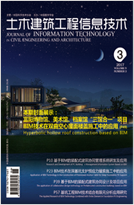2022, 14(1): 20-26. doi: 10.16670/j.cnki.cn11-5823/tu.2022.01.04
基于BIM与机器学习的建筑智能巡检眼镜研究
北京科技大学,北京 100083 |
The Search of Intelligent Architectural Inspection Glasses Based on BIM and Machine Learning
University of Science and Technology Beijing, Beijing 100083, China |
引用本文:
杨雅钧, 石轩潞, 唐禧妍, 靳晓勇, 许镇. 基于BIM与机器学习的建筑智能巡检眼镜研究[J]. 土木建筑工程信息技术,
2022, 14(1): 20-26.
doi: 10.16670/j.cnki.cn11-5823/tu.2022.01.04

Citation:
Yajun Yang, Xuanlu Shi, Xiyan Tang, Xiaoyong Jin, Zhen Xu. The Search of Intelligent Architectural Inspection Glasses Based on BIM and Machine Learning[J]. Journal of Information Technologyin Civil Engineering and Architecture,
2022, 14(1): 20-26.
doi: 10.16670/j.cnki.cn11-5823/tu.2022.01.04

摘要:如今我国BIM行业发展迅速,与人工智能结合应用已成为热门趋势。针对建筑巡检时仪器携带不便,且人工误差难以避免等问题,设计了基于BIM与机器学习的建筑智能巡检眼镜,实现了巡检设备的便携化与自动化。首先基于机器学习对建筑构件图片进行训练,实现构件识别功能;其次通过Dynamo可视化编程快速提取建筑构件信息;最后以树莓派为硬件载体设计建筑智能巡检眼镜,可准确识别建筑构件类型。本文方法可以大幅提升巡检效率,实现BIM技术与人工智能等领域的进一步融合。
Abstract: With the rapid development of BIM industry, the application of BIM combined with artificial intelligence has become a prevalent trend. In order to solve the problems of inconvenient carrying apparatus and unavoidable manual errors in building inspection, intelligent inspection glasses based on BIM and machine learning are designed, which enables the process to be portable and automated.Firstly, building component images are trained based on machine learning to realize component recognition; secondly, information of architectural components should be fetched quickly through the visualization program-Dynamo; finally, Raspberry Pi(RPi)is used to design intelligent inspection glasses, and the detection results can accurately identify the types of building components. This method can not only greatly improve the efficiency of inspection but also make the further integration of BIM technology and artificial intelligence realized.
| [1] |
中华人民共和国住房和城乡建设部. 2016-2020年建筑业信息化发展纲要[EB/OL]. (2016-08-23)[2021-04-30]. http://www.mohurd.gov.cn/wjfb/201609/t20160918_228929.html. |
| [2] |
易礼珍. BIM、物联网、云计算在地铁机电设备运维管理中的应用研究[J]. 福建建材, 2016(8): 110-112. |
| [3] |
黄国, 林球英, 李雄均. 基于AR智能眼镜的变电站可视化巡检平台设计[J]. 电子元器件与信息技术, 2021, 5(1): 77-78. |
| [4] |
徐宝军, 李新海, 罗海鑫, 等. 基于建筑信息模型技术的变电站机器人智能巡检系统研究与应用[J]. 供用电, 2020, 37(11): 8-14. |
| [5] |
苗智慧. 基于BIM的建筑设备可视化运维管理系统研究[J/OL]. 土木建筑工程信息技术: 1-10[2021-04-29]. http://kns.cnki.net/kcms/detail/11.5823.TU.20210312.1711.002.html. |
| [6] |
吴生海, 刘陕南, 刘永哓, 等. 基于Dynamo可视化编程建模的BIM技术应用与分析[J]. 工业建筑, 2018, 48(2): 35-38+15. |
| [7] |
汪勇, 付豪. BIM可视化编程技术在桥梁上的应用——Dynamo初探[J]. 城市道桥与防洪, 2021(1): 187-190+20. |
| [8] |
王婷, 池文婷. BIM技术在4D施工进度模拟的应用探讨[J]. 图学学报, 2015, 36(2): 306-311.doi: 10.3969/j.issn.2095-302X.2015.02.026 |
| [9] |
周志华. 机器学习[M]. 北京: 清华大学出版社, 2016: 113-114. ZHOU Z H. Machine learning[M]. Beijing: Tsinghua University Press, 2016, 113-114. |
| [10] | |
| [11] |
李少愚. 微博虚假信息鉴别技术验证平台的设计与实现[D]. 北京邮电大学, 2019. |
| [12] |
欧阳森, 张真. 基于树莓派的预防性轻型除冰机器人行走控制系统设计[J]. 电气传动, 2021, 51(8): 71-76. |
| [13] |
李晓蕊. 基于迁移学习的铁路异物检测算法研究[D]. 北京交通大学, 2018. |
| [14] |
衣柳成, 魏伟波, 刘小芳. 基于GoogLeNet的智能录播系统中站立人脸的检测与定位[J]. 青岛大学学报(自然科学版), 2019, 32(4): 91-95. |
| [15] |
贾雪微. 基于PCANet-LDA的移动机器人闭环检测研究[D]. 哈尔滨工业大学, 2019. |
| [16] |
张邻. 基于BIM与GIS技术在场地分析上的应用研究[J]. 四川建筑科学研究, 2014, 40(5): 327-329 |
计量
- PDF下载量(62)
- 文章访问量(2439)
- HTML全文浏览量(1274)















